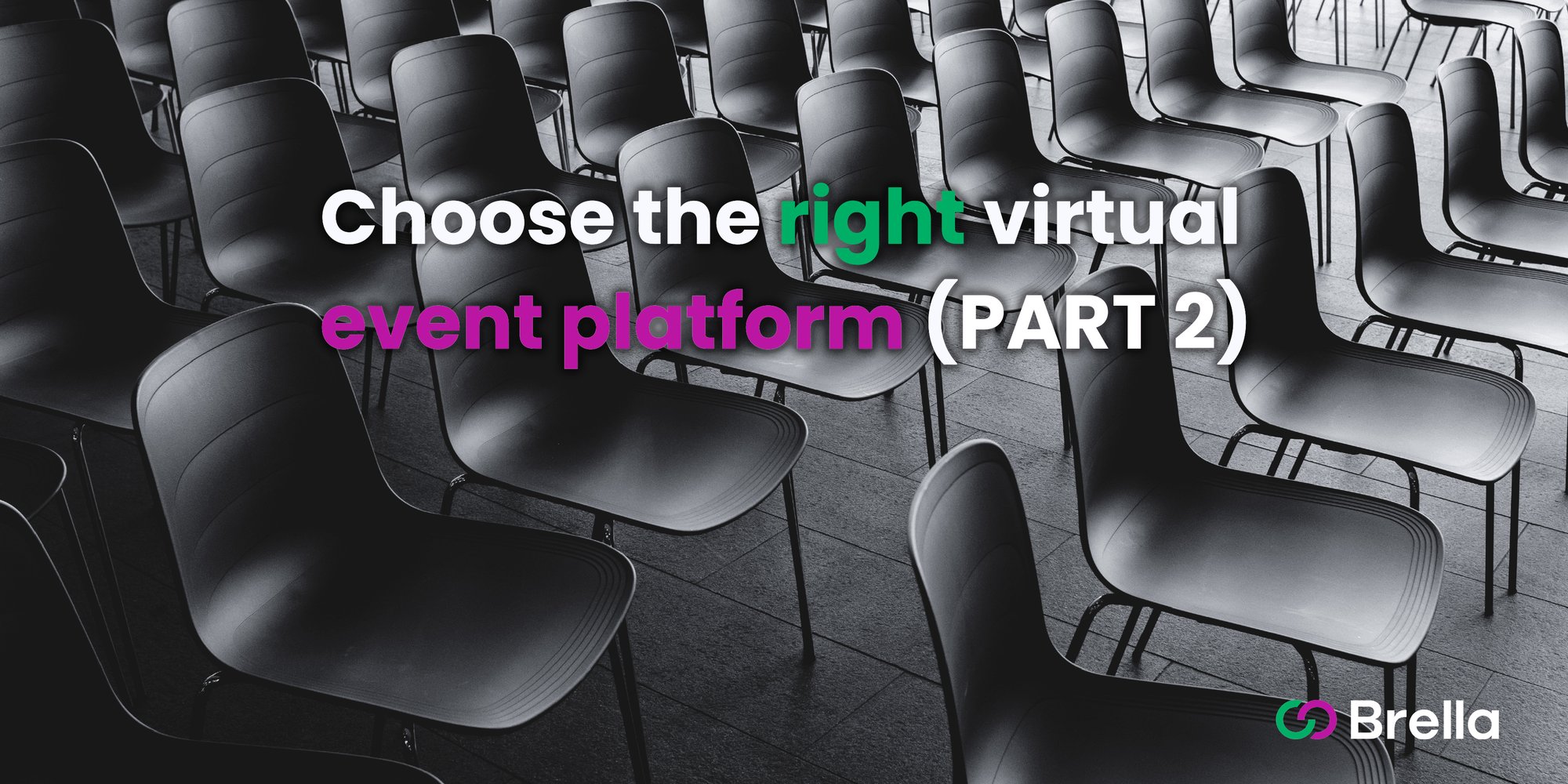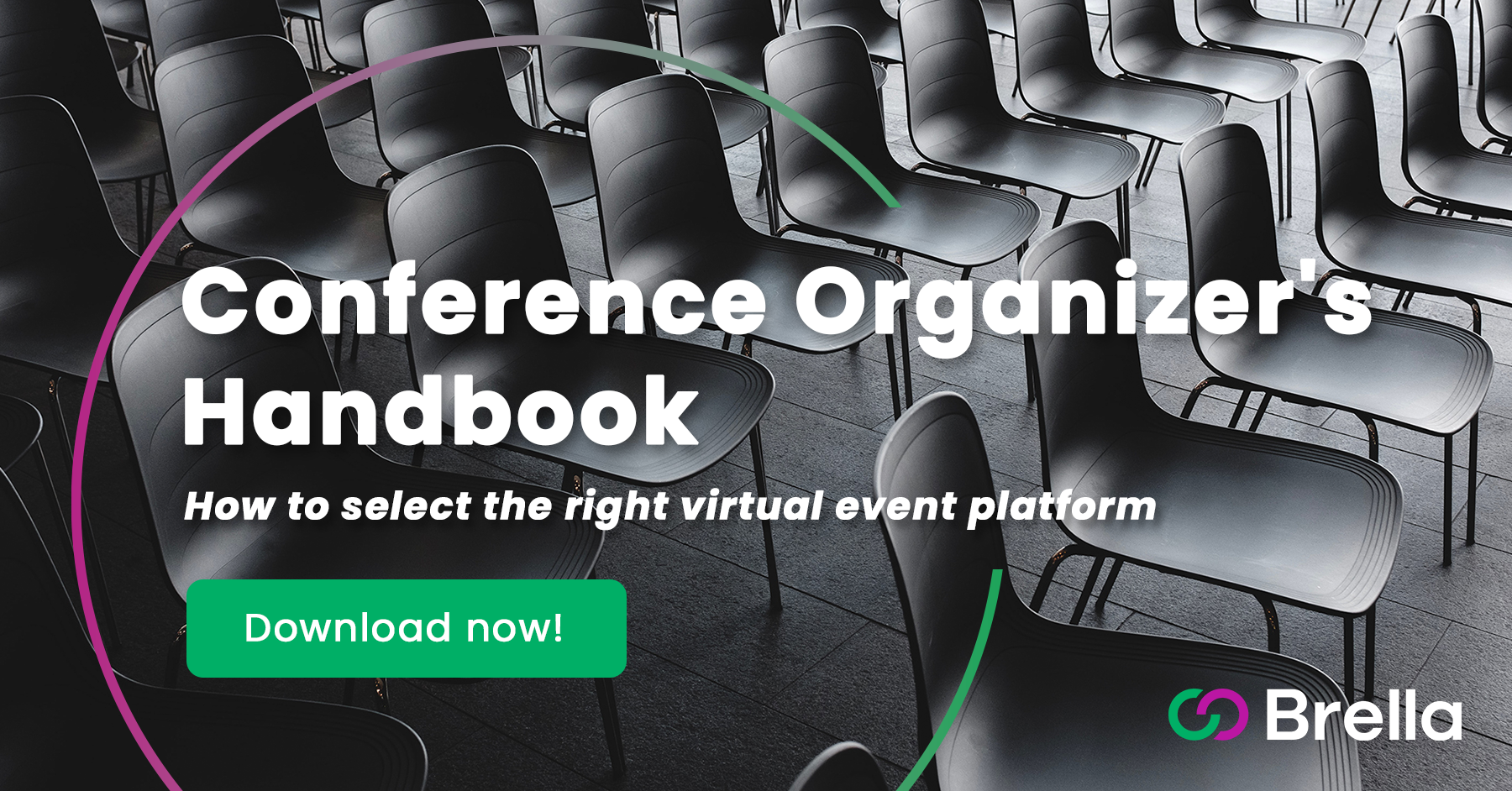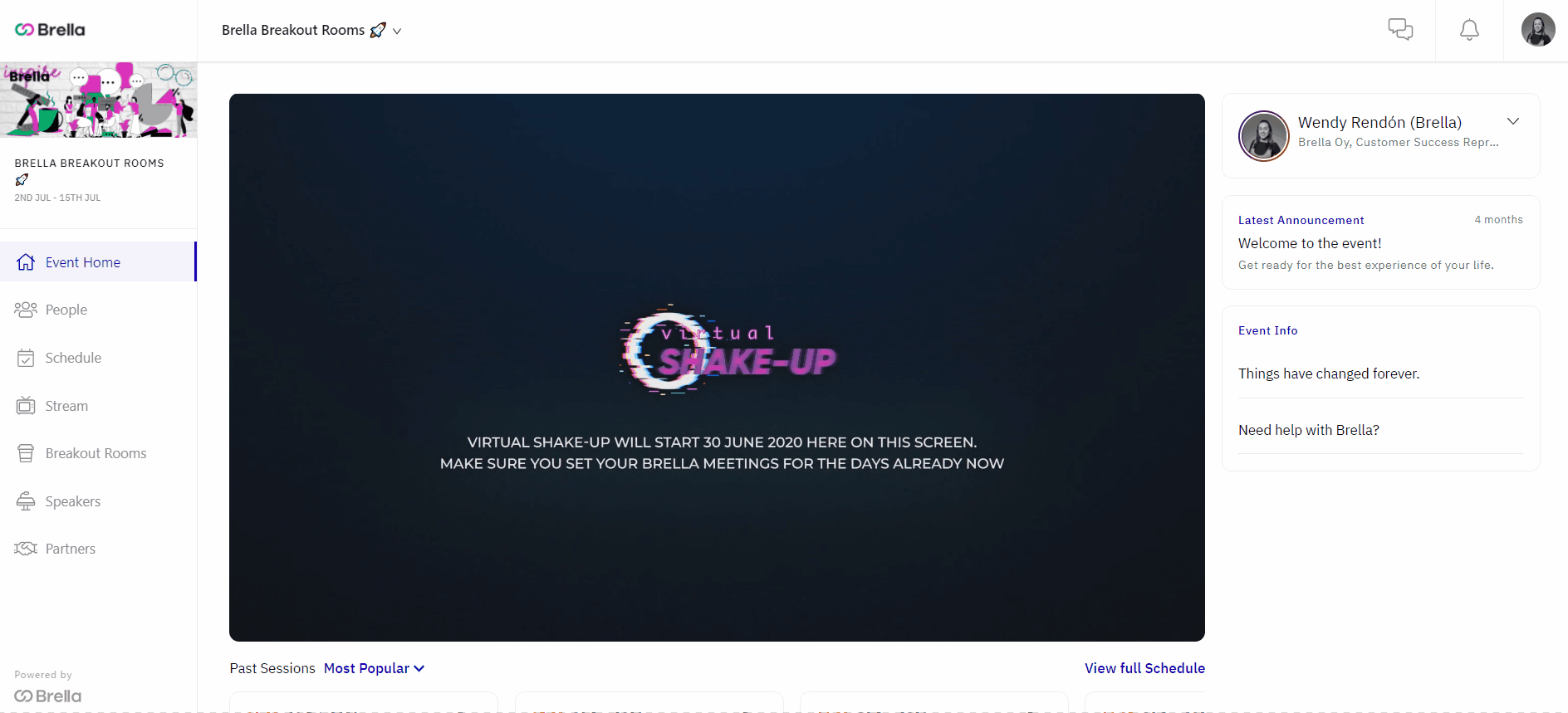Choosing the right virtual event platform for your conference takes careful thought as it will dictate the possibilities and potential of your virtual event.
Don't worry - in this article, we'll tell you everything you need to know about picking the right virtual event platform for your conference.
In Part 1 we covered the essential features your virtual event platform should offer in order to fully support content hosting & distribution, audience engagement, and networking.
In this second part, we'll walk you through the last two key components:
- Revenue generation
- Event data & analytics
And if you're planning or you're about to plan your next virtual event, our Conference Organizer's Handbook will teach you how to choose the best virtual event platform and how to get the absolute most out of your next virtual event.
Revenue generation
While at the start of 2020 it wasn't easy to monetize virtual events, the revenue opportunities for both you and your sponsors are now impressive.
At a traditional in-person event, there are one or two main ways to generate revenue:
- Ticket sales
- Sponsorships
But holding a virtual event can generate considerably more revenue than an in-person event.
How?
Increased reach and attendance
By removing the need to have a set location for your conference, potential attendees can join from all over the world, without the need to book hotels or flights.
As well, without the need to find a location that will host the number of attendees you are expecting and running the risk of selling out of tickets simply due to venue restrictions, your conference has no attendee limit. No more worrying about venue size, fire codes, security restrictions, or more.
Your virtual event is also far more accessible. Those wishing to attend can do so from their home, on holiday, or at the office. They can also watch on their phone, laptop or computer; they can watch it live, or watch the replay later.
In the end, hosting a virtual event means you open your event up to more people, and ensure they can consume your content in a more accessible manner.
After being forced virtual, Emax improved their reach and their networking KPIs using Brella. Read their story here.
Sponsorship opportunities
Our industry data gathered from over 10,000 events from 2016 to 2021 has shown that sponsors have started to see the potential of virtual events and are now sending more representatives to virtual events to increase their performance and ROI.
So, why is your virtual event so valuable to sponsors?
- First of all, not only is the number of attendees at virtual events typically higher than in-person, the demographic will be far wider. This expanded reach and ease of attending leads to a larger lead pool for sponsors, meaning they also get the benefits of expanded reach.
- Second, thanks to in-depth data analytics, you can provide your sponsors with accurate information on who is attending, what their interests are, and virtual 1:1 meeting rooms to start the sales process early.
- Third, with the inherent reusability of virtual content, you can provide broader and long-lasting brand awareness to your sponsors. Whenever you reshare or drive more traffic to your sessions after your conference, your sponsors' brand will be there, furthering their brand.
If you want to learn more on how to secure better sponsorship deals for your next virtual event we have compiled our 6 proven tactics here.
Plus, the right virtual event platform will offer many more irresistible opportunities for your sponsors in terms of event analytics and ROI.
Let's have a look at them!
Traffic and ROI analytics
For sponsors:
A virtual event allows you to track traffic and revenue, allowing you to calculate your return on investment (ROI). This is much easier to calculate than an in-person event because it is so much easier to track statistics of who is “coming and going” through a virtual platform than at a live event.
And perhaps the best feature is virtual exhibition halls and booths, which provide far more data capture opportunities and creative potential for sponsors.
Virtual booths are an effective way to showcase demos, product capabilities, as well as answer general queries. Thanks to Brella's new sponsor self-service feature, organizers can offer designated sponsor admins controlled access to build and customize their own booths.
All in all, whether you need to know how many attendees visited a session or a sponsor's booth, your virtual event platform should be able to tell you.
With sponsored sessions and breakout rooms sponsors can target their audience in a more intimate and interactive way
For you:
The virtual event only needs to be recorded once to be used forever.
This means that, once it is recorded, it can be cut and manipulated almost endlessly, making it possible to be used in so many different circumstances.
For example, parts of the event are likely going to be perfect for you to use in future marketing material (especially those parts that were really popular!). You, therefore, have yourself some brilliant marketing, that you know works for hardly any extra cost to you. This passive income will significantly improve your ROI.
Event data & analytics
Holding a virtual event can give you the opportunity to gather metrics that you wouldn’t otherwise be able to. In fact, if you are not using data to drive your business strategy, your competition will leave you behind.
Other than counting the number of attendees, and who signed up to attend each seminar, live events are difficult to produce any kind of usable data.
A virtual event can give you the opportunity to gather data you wouldn’t have been able to before, like:
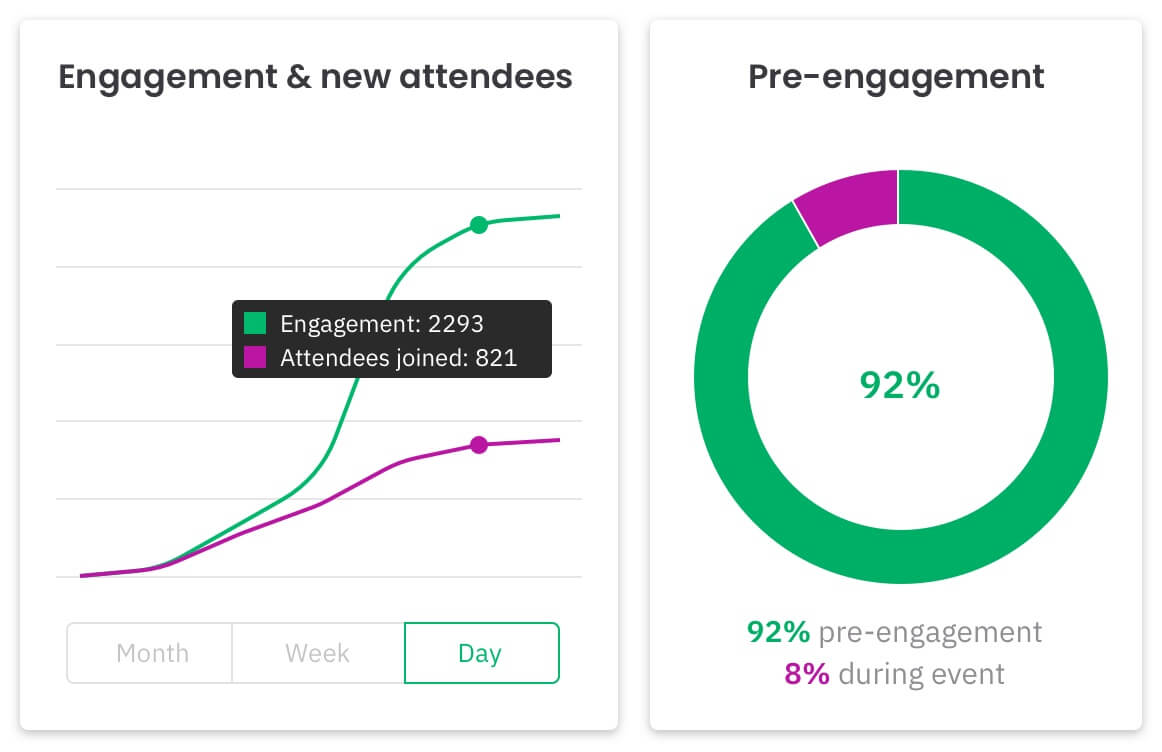
At a virtual conference, the barriers to entry are broken and you drastically improve your reach.
Livestream vitals
At an in-person event, you can count the number of people who bought tickets and then those who attended (to a degree). What you can’t do is record data on peoples’ engagement while they are at the event.
But you can do all that (and more) with a virtual conference.
Your livestream is the heart of your conference, so make sure your virtual event platform provides ample reporting on it to help you understand:
- The interests of your attendees
- The number of attendees and the amount of time people are spending viewing the event
- The questions participants asked
- Which parts of the event people are enjoying, sharing and the comments they are making about what they are watching, as they are watching it
- Where people are attending from, at what times, on what devices, who is watching live and who is watching a replay
- How many people are taking up opportunities to take part in separate seminars, 1:1 sessions with sponsors and speakers etc.
For the first time, you will have hard data rather than assumptions as to how your event was received by attendees.
These metrics are key to understanding your audience and what they want from you in the future, helping you host a better conference year after year.
It is important not only gather this information but to use it to your advantage.
Content performance
As we covered in Part 1, content is key and so it makes sense that you should be measuring its performance.
The analytics will help you to understand what content your attendees liked, want to see more of, didn’t find helpful, wanted to see that wasn’t there, and more.
These kinds of metrics are essential for selecting future content and will give you invaluable feedback that you wouldn’t otherwise have on what your participants thought of your event.
Market & content trends
Following on from the above, when you know what works and what your attendees enjoyed seeing, you can also combine that with matchmaking interests to create a detailed picture of the current market and content trends.
At in-person conferences, you could measure filled seats and social media discussion after the session to gain a minor understanding of your most popular sessions.
However, with the right virtual event platform, you can:
- Understand livestream views, entries, dropoffs, and more
- View the interests of attendees who participated
- Combine these to understand what sort of people participated in which content
By using the analytics to understand trends, you can create a detailed profile on what people like and don’t like from what you do. This is powerful information, both internally to inform strategy and externally as 1st-hand research and content.
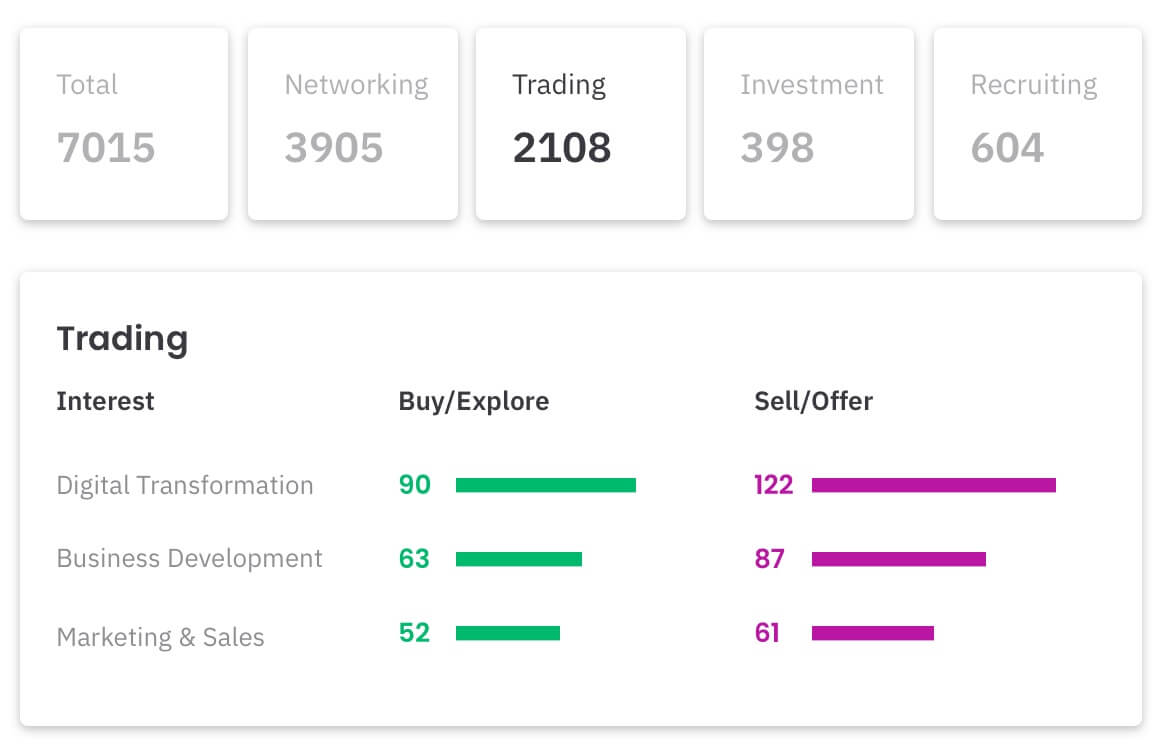 With the clever use of analytics, you can ensure your sponsors understand buyer intent and find the best leads.
With the clever use of analytics, you can ensure your sponsors understand buyer intent and find the best leads.
Buyer intent
The analytics you gather at your virtual event can help you to understand why people are or aren’t buying from you. They are the difference between knowing what your audience wants and taking an educated guess.
Not all prospects are created equal. Some are more ready to buy than others, and with a virtual conference you can understand their interests, the problems they face, and how warm or cold they were to your (or your sponsors') company.
All of this is incredibly useful information in helping your business improve and assisting both you and your sponsors with revenue generation down the line.
1:1 meetings
Understanding metrics for such things as the below are so important as networking engagement is vital to your virtual event:
- who met who?
- meeting requests sent and received
- meetings accepted and declined
This will tell you how well connections are being made amongst the attendees.
And along with 1:1 meetings, you can see the interests and titles of your attendees, to help you determine which segment of attendees appreciate networking most.
Provide the best virtual experience at your conference
When hosting a virtual conference, you need to consider how you will bring in revenue without having people attend the event in person as you would have had before.
You also need to consider how you will analyze your conference to determine its success and/or identify areas for improvement while also collecting numerical data that can be assessed and analyzed.
The best virtual event platforms can solve both of these issues with ease, ensuring you have a profitable and informative virtual conference.
In conclusion
The cost of hosting a virtual event against the revenue opportunities makes it so much more attractive than an in-person event. Revenue continues to come in for months, if not years, after the event itself as opposed to a one-day event when held in person. The ROI is incomparable.
Plus, having the opportunity to know what your attendees are thinking of your event in real-time is a true game-changer. The analytics available will help you adapt and evolve to design your event around what people want. From different types of content, to location and medium through which it is delivered.
Your virtual event platform must be flexible, versatile, and adaptable to both your needs and those of your attendees. If you want to learn everything there is to a competitive virtual event platform and how to get the absolute most out of your next virtual event, make sure you download our Conference Organizer's Handbook.
We also offer end-to-end support in planning your virtual event so that you don’t need to worry about planning the event yourself, taking away any additional stress or worry this might cause you.
Our event experts are here to help you, so book your free consultation call today and let's bring your next successful event to life together!
Read more
- Virtual events
- Hybrid events
- In-person events
- Event sponsorship
- Event engagement
- Event matchmaking
-
Brella news
-
Brella and Swoogo Partner for Optimized Event Experiences

-
Brella wins the Best Event App in the US & Canada

- START Global partners with Brella for a world-class networking experience
- Brella co-hosts The European Startup Conference to help Ukrainian tech ecosystem
- Next Block Expo partners with Brella for a world-class networking experience
-
- Meet a Brellaneer

